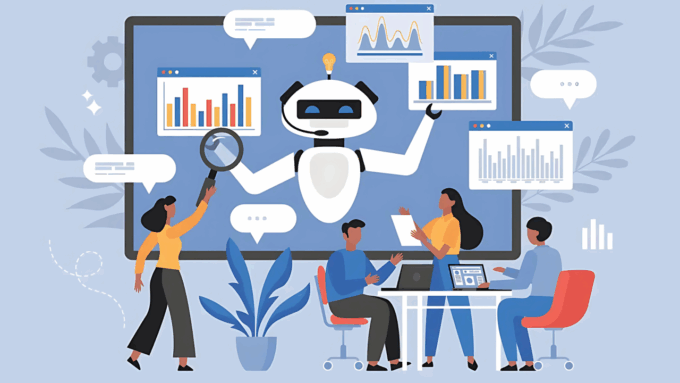Over the past few years, AI and ML have moved from niche experiments to real strategic levers, just ask any forward-looking CEO. But the trickiest shift isn’t the tech itself; it’s how leadership teams evolve to use it.
In many organizations, leadership remains a human domain of vision, trust, and culture. The question: how do you integrate AI/ML into leadership so that it amplifies, not undermines, the human strengths of your team?
Here’s what you’ll get in this piece:
- A grounded framework for how AI/ML can strengthen leadership capability
- Practical patterns and pitfalls from early adopters
- How to structure your team’s roles, decision flows, and development with AI in mind
- Key risks to watch for (because I’ve learned the hard way)
If your organization is starting to flirt with AI-powered decision support, predictive insights, or automated coaching, this is your roadmap for making that shift work, without blowing up your culture in the process.
What AI/ML means for leadership: a new axis of advantage

Source: linkedin.com
Let’s start by dropping the hype. AI and ML don’t replace leaders. They reframe leadership. The real value lies in enabling better decisions, adaptive teams, and faster learning loops, not in automating strategy, per se.
From research to battlefield case studies, a few patterns emerge:
- Better foresight, earlier signals: Predictive models can surface risks or opportunities weeks or months before they’re obvious to even seasoned execs.
- Personalized coaching/nudges: Imagine a tool that watches cross-team feedback, sentiment, project health—and nudges the CEO or department head with micro-recommendations (e.g., “Team A is slipping in morale; do a pulse check this week”).
- Bias checks and guardrails: ML models help spot systemic bias in decisions—who gets assigned new roles, who’s getting credit, who’s left out.
- Continuous feedback loops: Rather than annual reviews, leadership behaviors and outcomes can be monitored, tracked, and adjusted in near real time.
There’s evidence already. A controlled experiment found that teams aided by generative AI outperformed purely human teams across performance metrics. What’s more telling: when multiple AIs were introduced, returns diminished – suggesting that judicious integration (not wholesale replacement) is smarter.
But push too fast without human calibration, and AI becomes a hammer looking for nails. Leaders must adapt their roles accordingly.
How to embed AI in your leadership team structure (without backlash)

Source: linkedin.com
Let me map out a structure I’ve seen work—even in messy, high-growth companies. You can adapt it based on your size and domain.
A three-tier AI-enabled leadership stack
| Tier | Who owns it | Core role | Interactions |
| Strategic AI Council | CTO / Chief Data Officer + cross-functional leads | Define which uses of AI/ML align with strategy, budget, ethics, and guardrails | Monthly cadence; scenario reviews; “fail fast” portfolio |
| Leadership Support Engines | Analytics team + data scientists + UX designers | Build models, ML pipelines, dashboards, nudges, monitors | Embedded in business units; co-create with leadership |
| Operational Feedback Loop | Mid-level leaders (directors, VPs) | Apply insights internally: coaching, resource shifts, team optimization | Weekly reviews, micro-expts, feedback integration |
If AI/ML is just piloted in pockets without knowing who “owns” it at the top, you’ll hit friction. McKinsey’s recent analysis shows that 77 % of successful ML implementations had C-level sponsorship. That backing gives you authority, trust, and leeway.
Note: The operating teams must live at the boundary: technical enough to build models, business enough to know what really moves the needle.
Early roles you need: AI fluency, but not “data bros”
You’ll need to rethink job descriptions and roles in your leadership team. Here are a few that tend to matter most:
- AI Translator / Strategist – someone who bridges technical depth and business context. They can run scenario modeling with the CTO and then walk into a boardroom and explain what it means.
- Ethics & Trust Lead – AI will push you into corners around fairness, bias, and explainability. You want a champion who ensures your AI systems align with your values.
- Learning Facilitator – a leadership coach or L&D expert who designs how leaders absorb feedback from AI systems, interpret it, and act.
- Data Ops & Monitoring Lead – someone responsible not just for building models but maintaining model health, drift, anomalies, and alerting. AI projects decay fast if no one owns ongoing evolution.
I’ll drop in a real-world touchpoint here: Tech Ned Recruitment helps companies bring in specialized non-executive roles that carry AI, tech, or data domain knowledge. If your leadership team is lacking in that specialized domain experience, roles like NEDs (Non-Executive Directors) can bridge the gap externally and show you how to blend domain insight with governance. (More here: Tech Ned Recruitment)
These roles aren’t “nice to haves.” In a world where decisions become more data-driven, you’ll simply fall behind without them.
Scaling leadership behaviors with AI: a playbook

Source: amta.sg
You don’t flip a switch. You build in phases, with behaviors as your unit of change.
Stage 1: Echoes (observational insights)
Start with non-invasive systems that gather signals:
- Sentiment analysis from internal comms
- Project health metrics (velocity, blockers, dependencies)
- Signal aggregation (e.g., “10 % slower than forecast”
At this stage, leaders use the data as additional input, not directives.
Stage 2: Suggest (nudge layer)
Introduce suggestion systems:
- “I noticed Team X has three overdue dependencies. Would you like to block time to sync them?”
- “Your 1:1 cadence with Mgr B dropped; would you like to schedule a check-in?”
These are gentle aids, not mandates.
Stage 3: Partner (co-decision)
Here, AI tools become intelligent partners in decision-making:
- Scenario modeling (if we reallocate these resources, projected output = X)
- Optimizing allocation of leadership focus (which team needs attention this week)
- Coaching leaders in real time (e.g., “you interrupted 4 times in that meeting—try pausing before responding”)
Stage 4: Autonomous (rare, high trust)
Only in mature firms will some decisions be delegated (e.g., scheduling, flagging, low-risk resource shifts). At this point, guardrails must be very solid.
Did you know? More than 57 % of companies still struggle to build a true data-driven culture, even when they have advanced models in place. That shows how easy it is to invest in tech and neglect the human side. Don’t be that case study.
Common traps and how to avoid them
- “Tool Snobbery”: believing the latest algorithm solves everything. Reality check: leadership isn’t a pattern recognition game alone.
- Data as dictator: letting models deliver conclusions that go unchecked. Make sure every recommendation is annotated with assumptions and confidence levels.
- Neglecting emotional intelligence: AI can’t feel trust, nuance, context, or personal history. A leader’s relational instincts still matter.
- Drift & entropy: models degrade. If you let analytics rot, your leadership system becomes toxic.
- Opaque systems = fear: if teams don’t know why an AI nudge was made, they’ll reject it. Invest in explainability and visibility.
AI-led transformation in operations

Source: ptc.com
I worked with a fast-growing logistics firm where leaders were struggling to balance throughput, morale, and overtime costs. We piloted a leadership support engine:
- We built a dashboard tracking driver-team stress (via shift adherence, on-time deviations, and incident reports).
- We surfaced weekly “early-warning” signals to regional managers: e.g., “Line 3’s performance is slipping; predicted burnout risk is high.”
- Managers scheduled micro check-ins, resource reallocations, and shifted shift patterns proactively.
- Over 6 months, they reduced unplanned overtime by 18 %, increased throughput by 9 %, and saw fewer escalation tickets.
The key: the AI didn’t replace the manager’s judgment. It nudged it. Results came because leaders embraced it and iterated with feedback.
The leadership mindset shift you must make
If you want AI/ML to strengthen your leadership team (rather than fracture it), you’ll have to adopt three core mindset shifts:
- From oracle to curator
Leaders stop being ultimate deciders. They become curators of insight, working with AI outputs, but validating them through experience and judgment. - From silos to feedback loops
Leadership becomes less a top-down monolith and more a feedback ecosystem. AI helps flatten decision latency, but you need safe feedback loops. - From static roles to evolving roles
Some leaders will become “AI coaches,” others “data translators,” others “trust guardians.” You’ll need flexibility in titles, job descriptions, and responsibilities.
Action steps: how to get started this quarter
- Pick one leadership function (e.g., team health, decision support, coaching) and run a small pilot.
- Assign a cross-functional pair (business + data) to lead it, with clear guardrails.
- Establish C-level sponsorship explicitly; governance matters.
- Build transparency: every AI insight comes with “why and confidence.”
- Document learnings regularly and recalibrate.
If you treat AI/ML as a magical cure, you’ll fail. But if you treat it as a tool in the leadership toolkit, it can multiply your impact.
Final thoughts

Source: okoone.com
Trust me: integrating AI into leadership teams is messy, unpredictable—but worth doubling down on. Done right, AI doesn’t diminish leaders; it supports them, surfaces blind spots, accelerates growth, and helps build teams that can lead in complexity.
If you’re serious about this transformation, you don’t need to get every bit right on day one. Start, iterate, adapt—and keep your eyes on one north star: building leadership muscle that survives beyond any one tech wave.






